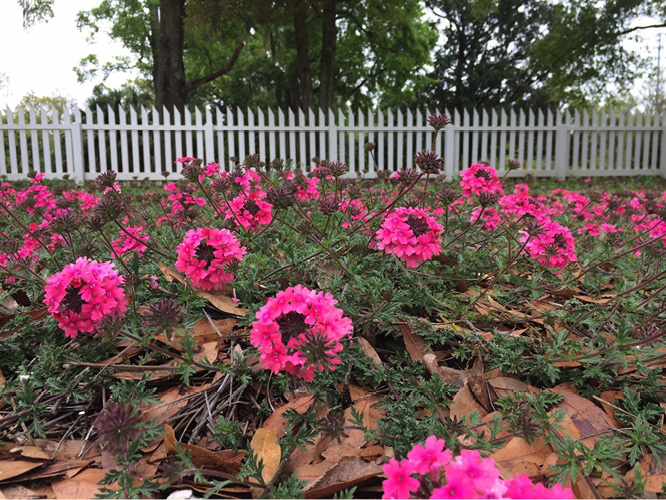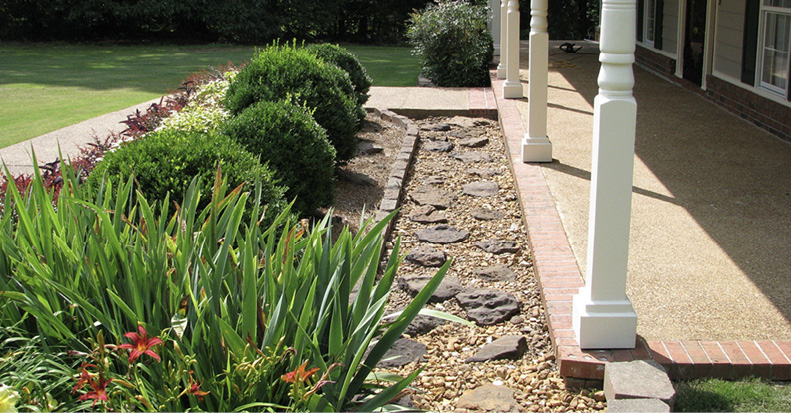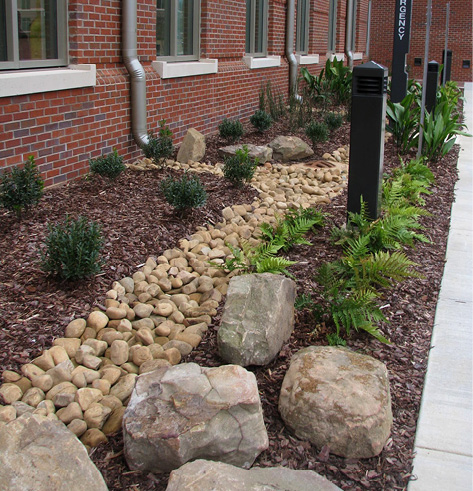Weed Management Strategies for Ornamental Landscape Beds and Ground Covers
Weed control in ornamental landscapes can be challenging. The diversity of plant material within these systems, and the types of weeds that occur, are very different from those of dense monoculture turfgrass. Frequent soil disturbance and the use of mulches further compound the complexity of weed control.
Design and Preparation
Ornamental landscapes require a large degree of planning and preparation in order to maximize their success. The most crucial step in ornamental bed preparation is planning. Selecting plant material and ensuring that the soil and site characteristics accommodate those plants are fundamental to successful landscapes. For instance, not all plants necessitate soil renovation; there are many that can readily handle wet, poorly drained soils or, alternatively, dry and unirrigated conditions. Healthy plants that compete with weeds for resources, such as nutrients, sunlight, and water, will help suppress weeds.
Small mass plantings make cultural practices and herbicide selection much easier during the maintenance of landscapes. Complex combinations of broadleaf, grass, and sedge plants may result in areas of the landscape where no chemical weed control is possible and ideal cultural practices are difficult to conduct.
Cultural weed control is crucial to a weed-free landscape. Dense plantings and year-round ground cover provide more weed suppression than even the best herbicide program. Achieving this density often requires multi-tiered plantings of upper-canopy plants supported by underlying ground covers (Figure 1).

Water management is an important function of many built landscapes. For example, landscapes can be designed to retain or slow runoff from impervious surfaces, such as roofs and parking lots (Figures 2 and 3). These landscapes are designed to slow rainwater infiltration through the natural soil, rather than being forced to run off quickly into sewers and streams. However, landscapes designed for such purposes must address two key issues:
- too much water runoff may disturb mulch and increase weeds, and
- too little surface and subsurface drainage may lead to soggy soil and, in turn, unhealthy landscape plants incapable of competing with opportunistic weeds.
Creative hardscapes can help alleviate these issues and also facilitate nonselective weed-control options. These hardscapes should be semi-pervious and accommodate excess runoff without soil erosion. In any case, proper soil amendments to allow drainage and nutrient retention are important principles that should not be overlooked in the design and installation of successful landscapes.


Common Weeds
Ornamental landscape weeds fall into two general categories: annuals that spread by seed and perennials that spread by vegetative material, such as rhizomes and stolons. Tables 1.1 and 1.2 list some of the most troublesome weeds. Annual weeds are generally easier to control because they are vulnerable to both hand removal and preemergence herbicides. Control of perennial weeds, such as tree saplings, smilax, poison ivy, nutsedge, Florida betony, and dollarweed, is largely accomplished by mechanical weed control (hand-pulling or hoeing) and application of postemergence herbicides.
|
Annual weed species |
Scientific name |
|---|---|
|
annual bluegrass |
Poa annua |
|
crabgrass |
Digitaria spp. |
|
goosegrass |
Eleusine indica |
|
foxtail |
Setaria spp. |
|
broadleaf-signalgrass |
Brachiaria platyphylla |
|
barnyardgrass |
Echinochloa spp. |
|
chamberbitter |
Phyllanthus urinaria |
|
annual sedges |
Cyperus spp. |
|
annual kyllinga |
Kyllinga sesquiflorus |
|
cock’s comb kyillinga |
Kyllinga squamulata |
|
doveweed |
Murdannia nudiflora |
|
spreading dayflower |
Commelina diffusa |
|
pigweed |
Amaranthus spp. |
|
Virginia buttonweed |
Diodia virginiana |
|
chickweed |
Stellaria media |
|
woodsorrel |
Oxalis spp. |
|
Perennial weed species |
Scientific name |
|---|---|
|
Bermudagrass |
Cynodon spp. |
|
Florida betony |
Stachys floridana |
|
false-green kyllinga |
Kyllinga gracillima |
|
green kyllinga |
Kyllinga brevifolia |
|
nutsedge |
Cyperus spp. |
|
knotroot foxtail |
Setaria parviflora |
|
greenbrier |
Smilax spp. |
|
dollarweed |
Hydrocotyle spp. |
Cultural Weed Control
Improper irrigation is most frequently at fault for weedy ornamental beds. When possible, landscape managers should irrigate based on plant demand rather than using daily or weekly irrigation timers. In most ornamental beds, there are intense flushes of weed emergence during the warm summer months when moisture is excessive (after rainfall or when landscapes are irrigated too much or too frequently).
Mulching materials can control weeds in ornamental landscapes. In the absence of a plant canopy, mulch prevents seedling establishment. However, excessive mulch can compromise the health of desired ornamentals. A mulch layer of 1 to 2 inches, and no more than 3 inches, is generally recommended. Apply mulch evenly around the base of shrubs and trees, and do not thesecreate mounds or “mulch volcanoes.”
Cloth weed barriers are relatively cheap (sometimes less than 10 cents per square foot), but they are rarely used during initial installations around home and commercial landscapes. In some instances where new landscape beds are installed, or old beds are being redesigned, this option makes sense, as long as these areas will not contain living ground covers or annuals.
Mechanical Weed Control
There is no substitute for hand-weeding of landscape beds. Complete chemical and cultural control of weeds is not possible. When hand-removing weeds, it’s important to excavate or extract roots because many plants have the ability to regrow from underground roots and stems. Applying mulch afterward may help suppress regrowing weeds.
Chemical Weed Control
Preemergence Herbicides
Preemergence herbicides (Table 2) inhibit seedling establishment and must be applied before significant weed emergence. Since these herbicides degrade over time, reapplication is required to maintain year-round effectiveness. Typical application dates are based on emergence cycles of common landscape weeds.
Apply in the spring before crabgrass emergence when soil temperatures at a 1-inch depth are below 55°F (typically mid- to late February in Mississippi). Apply a second late-spring/early-summer application roughly 6 to 10 weeks later. Recommendations differ for each product, so always read the label.
Time fall applications before annual bluegrass emergence when soil temperatures fall below roughly 70°F (typically mid- to late October in Mississippi).
Preemergence herbicides are formulated as either liquid or granular products. Each formulation has some distinct advantages. Liquid applications tend to saturate thick mulch layers and penetrate to the soil layer. Granular products may be able to penetrate dense plant canopies; however, these products can lodge in the sensitive whorls of desired plants.
|
Example product |
Active ingredient |
|---|---|
|
Hi-Yield Dimension |
dithiopyr |
|
Surflan, Balan |
oryzaline |
|
Pendulum 2G |
pendimethalin |
|
Pendulum Aquacap |
pendimethalin |
|
Lebanon Treflan 5G |
trifluralin |
|
Harrell’s 4.8G |
trifluralin + oxyfluorfen |
|
Freehand |
pendimethalin + dimethenamid |
|
Snapshot |
trifluralin + isoxaben |
|
Gemini |
prodiamine + isoxaben |
|
Showcase |
trifluralin + isoxaben + oxyfluorfen |
|
Goal |
oxyfluorfen |
|
Ronstar, RegalStar |
oxadiazon |
|
SureGuard, BroadStar |
flumioxazin |
|
Goose and Crab |
oxadiazon + bensulide |
|
Tower |
dimethanamid |
|
Devrinol 2G |
napropamide |
|
Gallery |
isoxaben |
|
Casoron 4G, Barrier |
dichlobenil |
|
Specticle G |
indaziflam |
|
Barricade 4FL |
prodiamine |
Postemergence Herbicides
Even with preemergence herbicides, some amount of hand-weeding will be required. Selective and nonselective herbicide application may also be necessary. Landscape managers should be properly trained to scout and identify sensitive plant material in order prevent damage to sensitive ornamentals.
When applying any herbicide, make sure to use a sprayer that is thoroughly rinsed and cleaned. The only way to be absolutely sure a sprayer is clean is to avoid using it to apply potentially harmful herbicides.
Grass Control
When applied appropriately, certain herbicides control grasses within broadleaf plantings (Table 3). These herbicides are sometimes referred to as ACCase inhibitors. They target a form of the ACCase enzyme that is unique to grass plants. For instance, sethoxydim and fluazifop control bermudagrass in non-grass plantings (e.g., Lirope, boxwood, and cedar).
Broadleaf Weed Control
Most ornamental plantings contain broadleaf plants. Herbicides that commonly control broadleaf weeds, such as 2,4-D and dicamba, are not safe on broadleaf ornamentals. However, some of these herbicides may have labels that allow selective application as long as there is no contact with foliage, bark, or roots of desired plant material. Table 3 suggests several popular postemergence herbicides with labeling for various weeds within certain ornamental plantings. Always use caution because all of these herbicides have the potential to be volatile and/or taken up by roots.
|
Weeds controlled or suppressed |
Trade name |
Active ingredient |
Labeled on |
|---|---|---|---|
|
grasses |
Segment, Vantage, Grass Getter |
sethoxydim |
mondograss, Liriope, monkeygrass, other broadleaf plantings |
|
Fusilade II, Ornamec |
fluazifop |
||
|
Envoy Plus |
clethodim |
||
|
Acclaim Extra |
fenoxaprop |
||
|
broadleaf weeds, yellow nutsedge, some grasses |
Basagran |
bentazon |
ajuga, boxwood, impatiens, English ivy, marigolds, ornamental cabbage, petunias |
|
yellow and purple nutsedge, Kyllinga species |
Sedgehammer, ProSedge |
halosulfuron |
Can be applied over the top of some ground covers and around the base of many woody ornamental trees and shrubs. |
|
yellow and purple nutsedge, Kyllinga species, pigweed, deadnettle, clover, hairy bittercress, chickweed, sicklepod |
Image |
imazaquin |
Most ground covers, including Liriope, Asiatic jasmine, juniper, and hosta, as well as around the base of many woody ornamental trees and shrubs. |
Non-selective Herbicides
Herbicides such as Round-up (glyphosate), Reward (diquat), and several other similar products cause injury and death of most ornamental weeds and landscape plants. Therefore, they should be used sparingly and only when applied selectively to undesirable weeds.
Conclusion
Proper design and installation, combined with cultural and mechanical weed-control methods, reduce pesticides required to maintain ornamental landscapes. Best practices include using proper site preparation and managing water to increase plant health and decrease soil disturbance. When herbicides are necessary, preemergence applications are the most effective strategy against common landscape weeds. When applied routinely, and before the germination cycle of common weeds, these herbicides are relatively safe and effective. Due to the diversity of plant material within ornamental landscapes, selective postemergence herbicides are scarce, and nonselective postemergence herbicides must be used carefully to prevent injury to desired plants.
For more information, please see MSU Extension Publication 1532 Weed Control Guidelines for Mississippi.
The information given here is for educational purposes only. References to commercial products, trade names, or suppliers are made with the understanding that no endorsement is implied and that no discrimination against other products or suppliers is intended.
Publication 3279 (POD-10-24)
By Jay McCurdy, PhD, Associate Professor, and Geoff Denny, PhD, former Assistant Extension Professor, Plant and Soil Sciences.
The Mississippi State University Extension Service is working to ensure all web content is accessible to all users. If you need assistance accessing any of our content, please email the webteam or call 662-325-2262.



